Case Study: Google's Organizational Structure, Culture, and Evolution
VerifiedAdded on 2023/01/12
|8
|2506
|80
Case Study
AI Summary
This case study analyzes Google's organizational structure, focusing on the factors that influence its design and how it manages its dynamic processes for growth and evolution. The report explores how technological advancements, the size of the organization, global pressures, and the availability of a skilled workforce impact Google's structure. It delves into Google's organizational culture, including the use of Handy's model, and examines key aspects such as openness, innovation, ethical values, and the decision-making process. The analysis highlights how Google fosters innovation through its '20 percent time' policy and a culture that encourages employee engagement and effective decision-making. The study concludes that Google has successfully managed its dynamic business processes, leading to organizational growth and success within a competitive landscape.
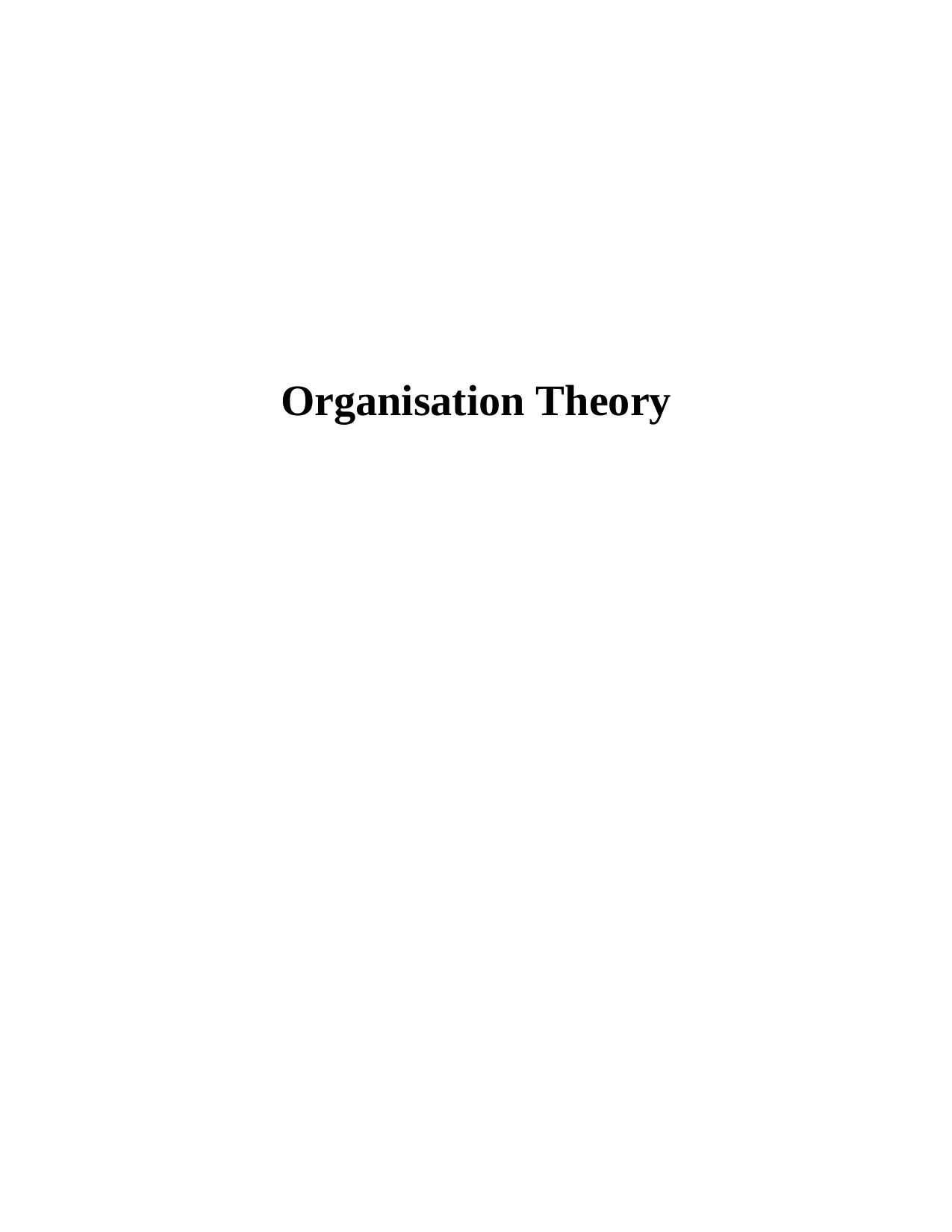
Organisation Theory
Paraphrase This Document
Need a fresh take? Get an instant paraphrase of this document with our AI Paraphraser
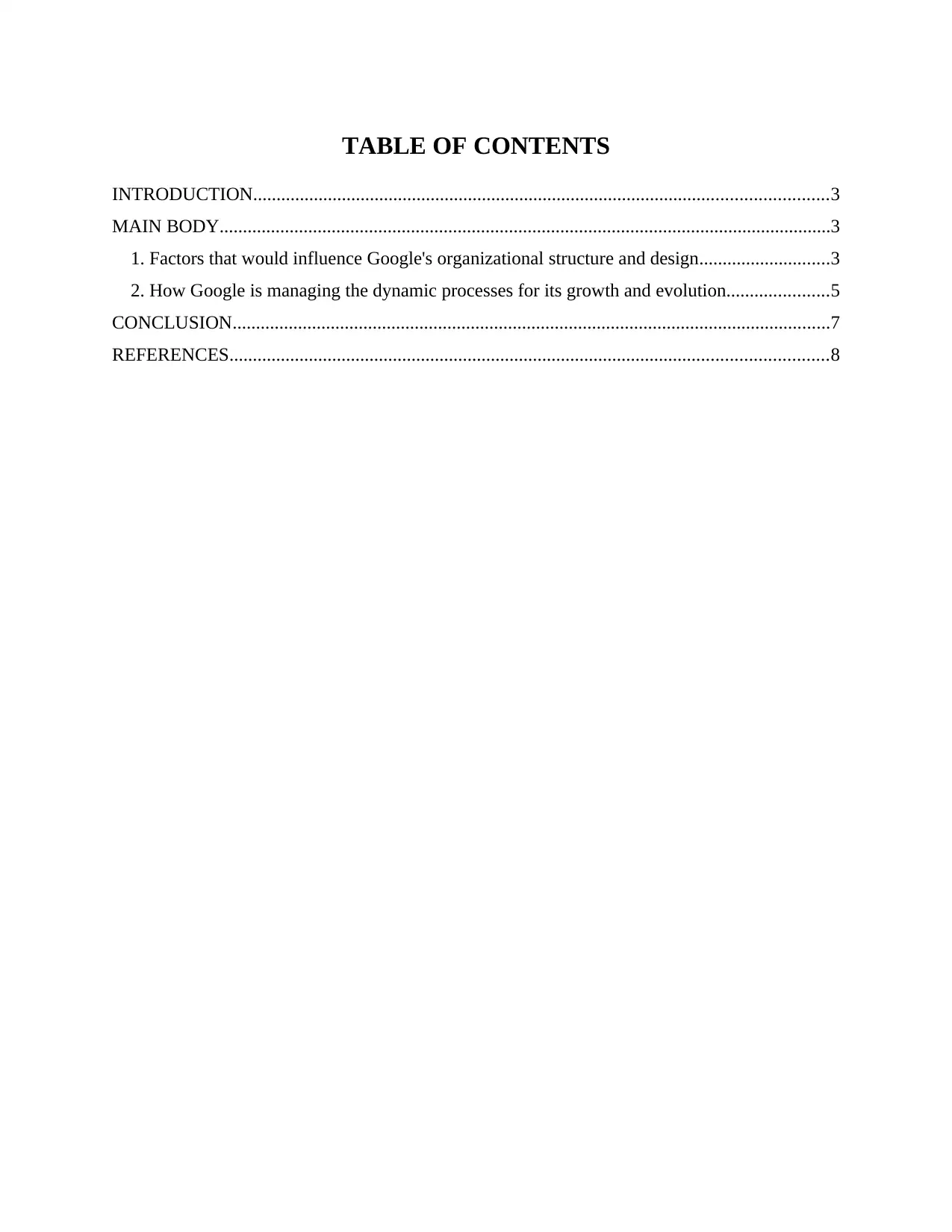
TABLE OF CONTENTS
INTRODUCTION...........................................................................................................................3
MAIN BODY...................................................................................................................................3
1. Factors that would influence Google's organizational structure and design............................3
2. How Google is managing the dynamic processes for its growth and evolution......................5
CONCLUSION................................................................................................................................7
REFERENCES................................................................................................................................8
INTRODUCTION...........................................................................................................................3
MAIN BODY...................................................................................................................................3
1. Factors that would influence Google's organizational structure and design............................3
2. How Google is managing the dynamic processes for its growth and evolution......................5
CONCLUSION................................................................................................................................7
REFERENCES................................................................................................................................8
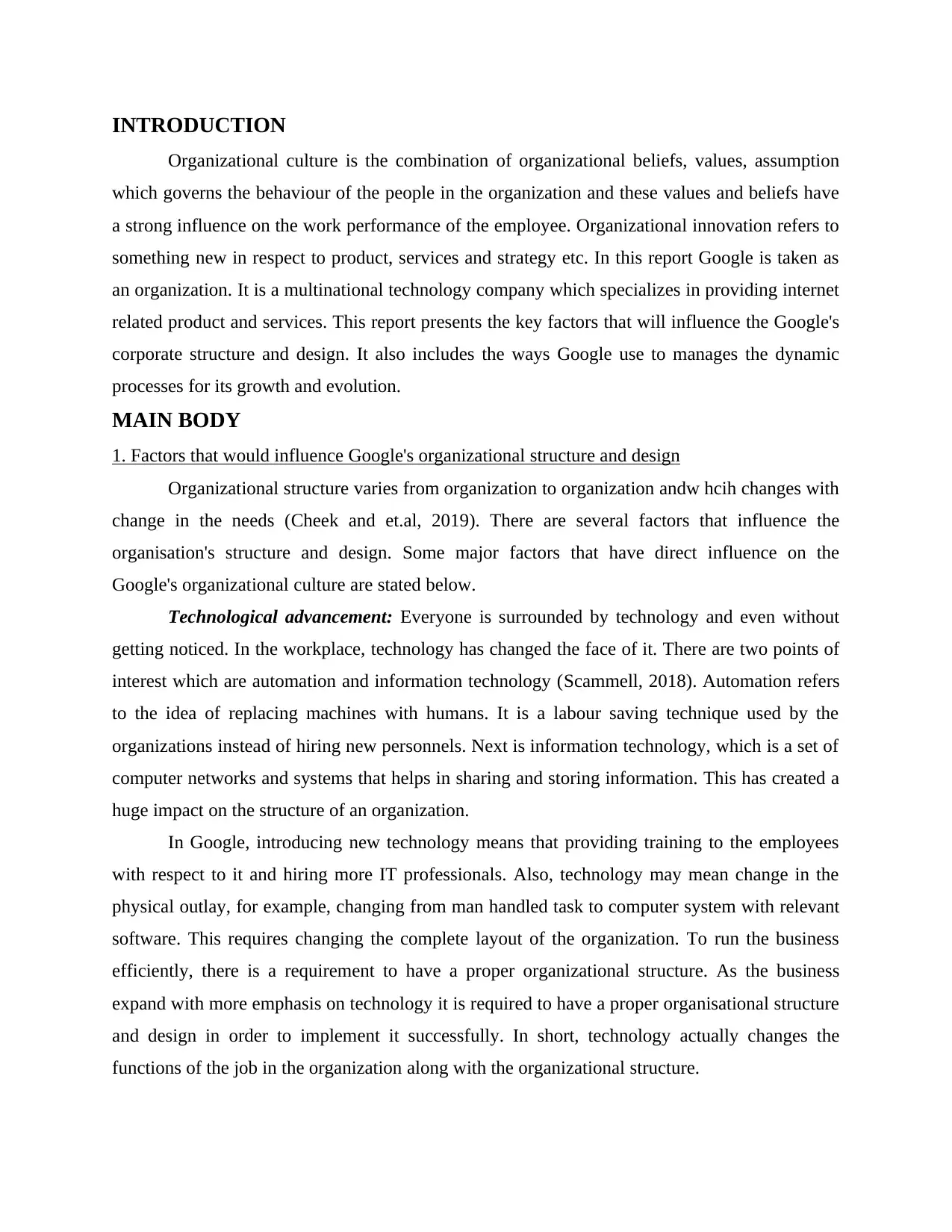
INTRODUCTION
Organizational culture is the combination of organizational beliefs, values, assumption
which governs the behaviour of the people in the organization and these values and beliefs have
a strong influence on the work performance of the employee. Organizational innovation refers to
something new in respect to product, services and strategy etc. In this report Google is taken as
an organization. It is a multinational technology company which specializes in providing internet
related product and services. This report presents the key factors that will influence the Google's
corporate structure and design. It also includes the ways Google use to manages the dynamic
processes for its growth and evolution.
MAIN BODY
1. Factors that would influence Google's organizational structure and design
Organizational structure varies from organization to organization andw hcih changes with
change in the needs (Cheek and et.al, 2019). There are several factors that influence the
organisation's structure and design. Some major factors that have direct influence on the
Google's organizational culture are stated below.
Technological advancement: Everyone is surrounded by technology and even without
getting noticed. In the workplace, technology has changed the face of it. There are two points of
interest which are automation and information technology (Scammell, 2018). Automation refers
to the idea of replacing machines with humans. It is a labour saving technique used by the
organizations instead of hiring new personnels. Next is information technology, which is a set of
computer networks and systems that helps in sharing and storing information. This has created a
huge impact on the structure of an organization.
In Google, introducing new technology means that providing training to the employees
with respect to it and hiring more IT professionals. Also, technology may mean change in the
physical outlay, for example, changing from man handled task to computer system with relevant
software. This requires changing the complete layout of the organization. To run the business
efficiently, there is a requirement to have a proper organizational structure. As the business
expand with more emphasis on technology it is required to have a proper organisational structure
and design in order to implement it successfully. In short, technology actually changes the
functions of the job in the organization along with the organizational structure.
Organizational culture is the combination of organizational beliefs, values, assumption
which governs the behaviour of the people in the organization and these values and beliefs have
a strong influence on the work performance of the employee. Organizational innovation refers to
something new in respect to product, services and strategy etc. In this report Google is taken as
an organization. It is a multinational technology company which specializes in providing internet
related product and services. This report presents the key factors that will influence the Google's
corporate structure and design. It also includes the ways Google use to manages the dynamic
processes for its growth and evolution.
MAIN BODY
1. Factors that would influence Google's organizational structure and design
Organizational structure varies from organization to organization andw hcih changes with
change in the needs (Cheek and et.al, 2019). There are several factors that influence the
organisation's structure and design. Some major factors that have direct influence on the
Google's organizational culture are stated below.
Technological advancement: Everyone is surrounded by technology and even without
getting noticed. In the workplace, technology has changed the face of it. There are two points of
interest which are automation and information technology (Scammell, 2018). Automation refers
to the idea of replacing machines with humans. It is a labour saving technique used by the
organizations instead of hiring new personnels. Next is information technology, which is a set of
computer networks and systems that helps in sharing and storing information. This has created a
huge impact on the structure of an organization.
In Google, introducing new technology means that providing training to the employees
with respect to it and hiring more IT professionals. Also, technology may mean change in the
physical outlay, for example, changing from man handled task to computer system with relevant
software. This requires changing the complete layout of the organization. To run the business
efficiently, there is a requirement to have a proper organizational structure. As the business
expand with more emphasis on technology it is required to have a proper organisational structure
and design in order to implement it successfully. In short, technology actually changes the
functions of the job in the organization along with the organizational structure.
⊘ This is a preview!⊘
Do you want full access?
Subscribe today to unlock all pages.

Trusted by 1+ million students worldwide
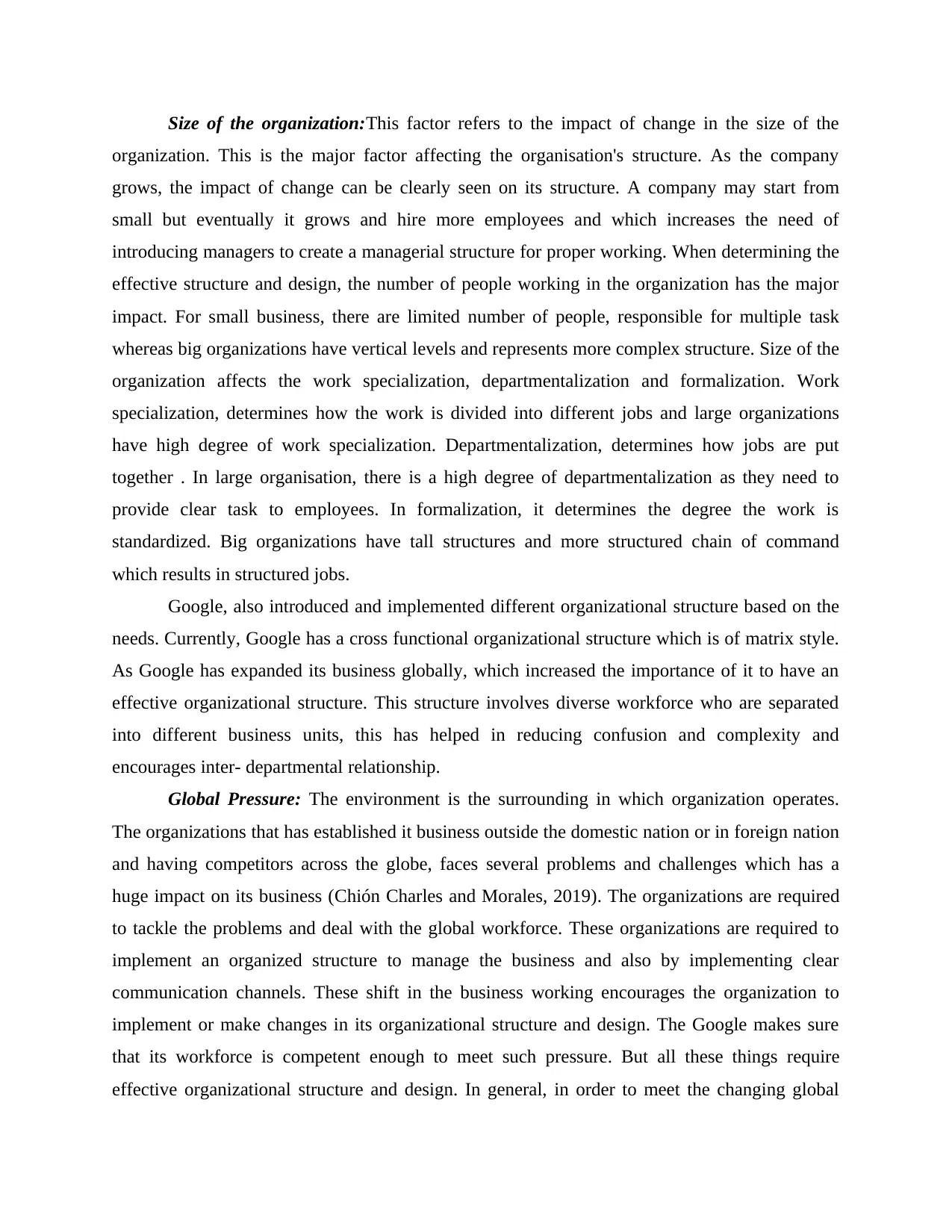
Size of the organization:This factor refers to the impact of change in the size of the
organization. This is the major factor affecting the organisation's structure. As the company
grows, the impact of change can be clearly seen on its structure. A company may start from
small but eventually it grows and hire more employees and which increases the need of
introducing managers to create a managerial structure for proper working. When determining the
effective structure and design, the number of people working in the organization has the major
impact. For small business, there are limited number of people, responsible for multiple task
whereas big organizations have vertical levels and represents more complex structure. Size of the
organization affects the work specialization, departmentalization and formalization. Work
specialization, determines how the work is divided into different jobs and large organizations
have high degree of work specialization. Departmentalization, determines how jobs are put
together . In large organisation, there is a high degree of departmentalization as they need to
provide clear task to employees. In formalization, it determines the degree the work is
standardized. Big organizations have tall structures and more structured chain of command
which results in structured jobs.
Google, also introduced and implemented different organizational structure based on the
needs. Currently, Google has a cross functional organizational structure which is of matrix style.
As Google has expanded its business globally, which increased the importance of it to have an
effective organizational structure. This structure involves diverse workforce who are separated
into different business units, this has helped in reducing confusion and complexity and
encourages inter- departmental relationship.
Global Pressure: The environment is the surrounding in which organization operates.
The organizations that has established it business outside the domestic nation or in foreign nation
and having competitors across the globe, faces several problems and challenges which has a
huge impact on its business (Chión Charles and Morales, 2019). The organizations are required
to tackle the problems and deal with the global workforce. These organizations are required to
implement an organized structure to manage the business and also by implementing clear
communication channels. These shift in the business working encourages the organization to
implement or make changes in its organizational structure and design. The Google makes sure
that its workforce is competent enough to meet such pressure. But all these things require
effective organizational structure and design. In general, in order to meet the changing global
organization. This is the major factor affecting the organisation's structure. As the company
grows, the impact of change can be clearly seen on its structure. A company may start from
small but eventually it grows and hire more employees and which increases the need of
introducing managers to create a managerial structure for proper working. When determining the
effective structure and design, the number of people working in the organization has the major
impact. For small business, there are limited number of people, responsible for multiple task
whereas big organizations have vertical levels and represents more complex structure. Size of the
organization affects the work specialization, departmentalization and formalization. Work
specialization, determines how the work is divided into different jobs and large organizations
have high degree of work specialization. Departmentalization, determines how jobs are put
together . In large organisation, there is a high degree of departmentalization as they need to
provide clear task to employees. In formalization, it determines the degree the work is
standardized. Big organizations have tall structures and more structured chain of command
which results in structured jobs.
Google, also introduced and implemented different organizational structure based on the
needs. Currently, Google has a cross functional organizational structure which is of matrix style.
As Google has expanded its business globally, which increased the importance of it to have an
effective organizational structure. This structure involves diverse workforce who are separated
into different business units, this has helped in reducing confusion and complexity and
encourages inter- departmental relationship.
Global Pressure: The environment is the surrounding in which organization operates.
The organizations that has established it business outside the domestic nation or in foreign nation
and having competitors across the globe, faces several problems and challenges which has a
huge impact on its business (Chión Charles and Morales, 2019). The organizations are required
to tackle the problems and deal with the global workforce. These organizations are required to
implement an organized structure to manage the business and also by implementing clear
communication channels. These shift in the business working encourages the organization to
implement or make changes in its organizational structure and design. The Google makes sure
that its workforce is competent enough to meet such pressure. But all these things require
effective organizational structure and design. In general, in order to meet the changing global
Paraphrase This Document
Need a fresh take? Get an instant paraphrase of this document with our AI Paraphraser
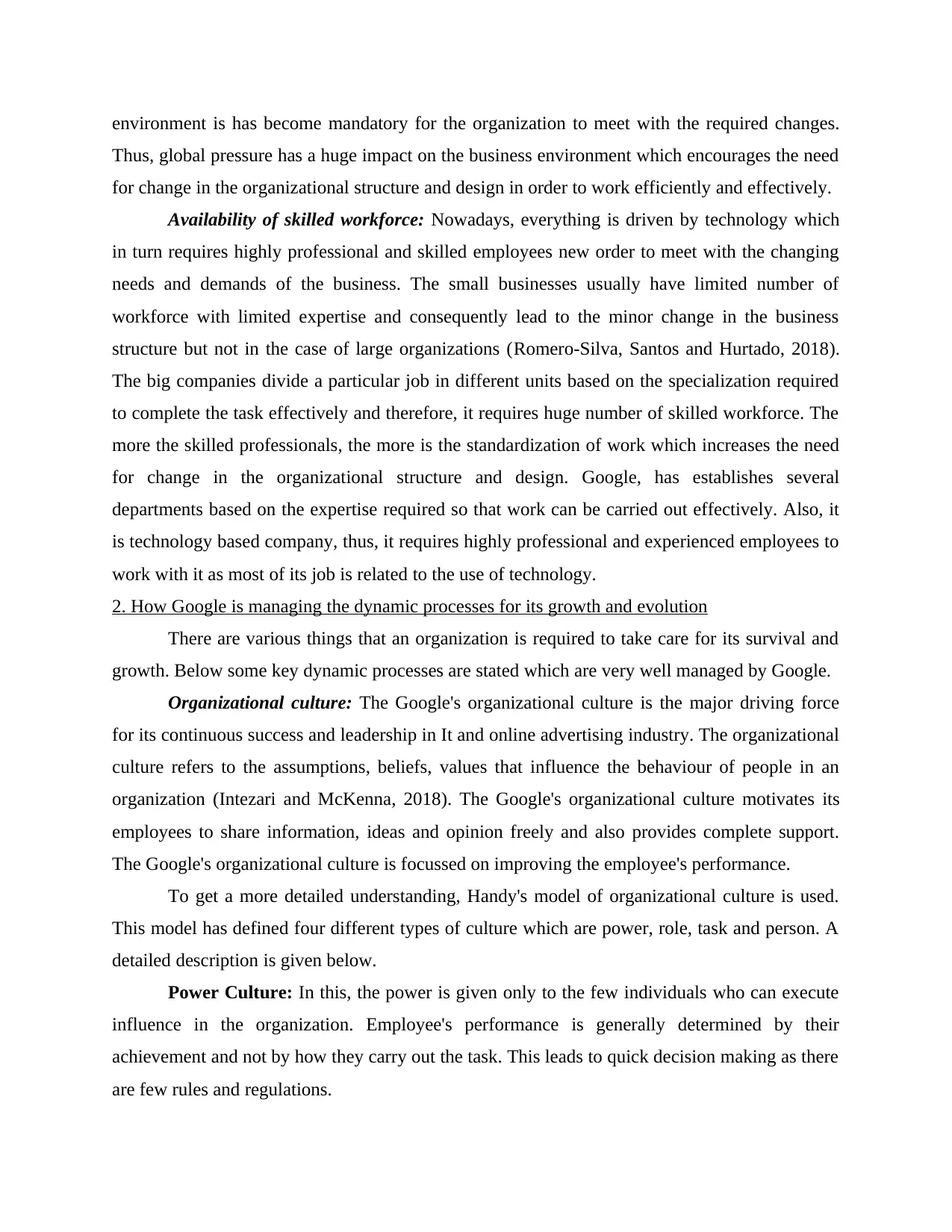
environment is has become mandatory for the organization to meet with the required changes.
Thus, global pressure has a huge impact on the business environment which encourages the need
for change in the organizational structure and design in order to work efficiently and effectively.
Availability of skilled workforce: Nowadays, everything is driven by technology which
in turn requires highly professional and skilled employees new order to meet with the changing
needs and demands of the business. The small businesses usually have limited number of
workforce with limited expertise and consequently lead to the minor change in the business
structure but not in the case of large organizations (Romero-Silva, Santos and Hurtado, 2018).
The big companies divide a particular job in different units based on the specialization required
to complete the task effectively and therefore, it requires huge number of skilled workforce. The
more the skilled professionals, the more is the standardization of work which increases the need
for change in the organizational structure and design. Google, has establishes several
departments based on the expertise required so that work can be carried out effectively. Also, it
is technology based company, thus, it requires highly professional and experienced employees to
work with it as most of its job is related to the use of technology.
2. How Google is managing the dynamic processes for its growth and evolution
There are various things that an organization is required to take care for its survival and
growth. Below some key dynamic processes are stated which are very well managed by Google.
Organizational culture: The Google's organizational culture is the major driving force
for its continuous success and leadership in It and online advertising industry. The organizational
culture refers to the assumptions, beliefs, values that influence the behaviour of people in an
organization (Intezari and McKenna, 2018). The Google's organizational culture motivates its
employees to share information, ideas and opinion freely and also provides complete support.
The Google's organizational culture is focussed on improving the employee's performance.
To get a more detailed understanding, Handy's model of organizational culture is used.
This model has defined four different types of culture which are power, role, task and person. A
detailed description is given below.
Power Culture: In this, the power is given only to the few individuals who can execute
influence in the organization. Employee's performance is generally determined by their
achievement and not by how they carry out the task. This leads to quick decision making as there
are few rules and regulations.
Thus, global pressure has a huge impact on the business environment which encourages the need
for change in the organizational structure and design in order to work efficiently and effectively.
Availability of skilled workforce: Nowadays, everything is driven by technology which
in turn requires highly professional and skilled employees new order to meet with the changing
needs and demands of the business. The small businesses usually have limited number of
workforce with limited expertise and consequently lead to the minor change in the business
structure but not in the case of large organizations (Romero-Silva, Santos and Hurtado, 2018).
The big companies divide a particular job in different units based on the specialization required
to complete the task effectively and therefore, it requires huge number of skilled workforce. The
more the skilled professionals, the more is the standardization of work which increases the need
for change in the organizational structure and design. Google, has establishes several
departments based on the expertise required so that work can be carried out effectively. Also, it
is technology based company, thus, it requires highly professional and experienced employees to
work with it as most of its job is related to the use of technology.
2. How Google is managing the dynamic processes for its growth and evolution
There are various things that an organization is required to take care for its survival and
growth. Below some key dynamic processes are stated which are very well managed by Google.
Organizational culture: The Google's organizational culture is the major driving force
for its continuous success and leadership in It and online advertising industry. The organizational
culture refers to the assumptions, beliefs, values that influence the behaviour of people in an
organization (Intezari and McKenna, 2018). The Google's organizational culture motivates its
employees to share information, ideas and opinion freely and also provides complete support.
The Google's organizational culture is focussed on improving the employee's performance.
To get a more detailed understanding, Handy's model of organizational culture is used.
This model has defined four different types of culture which are power, role, task and person. A
detailed description is given below.
Power Culture: In this, the power is given only to the few individuals who can execute
influence in the organization. Employee's performance is generally determined by their
achievement and not by how they carry out the task. This leads to quick decision making as there
are few rules and regulations.
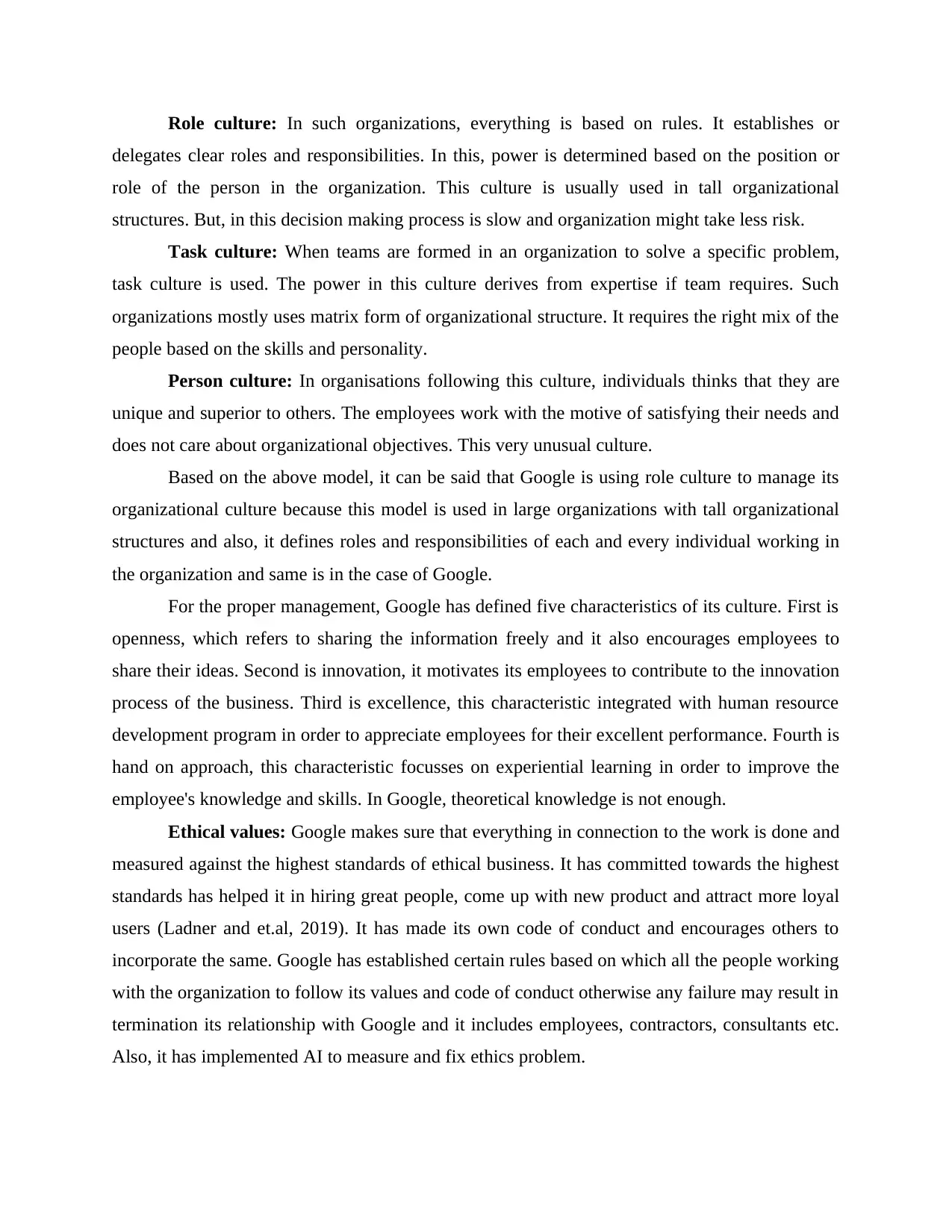
Role culture: In such organizations, everything is based on rules. It establishes or
delegates clear roles and responsibilities. In this, power is determined based on the position or
role of the person in the organization. This culture is usually used in tall organizational
structures. But, in this decision making process is slow and organization might take less risk.
Task culture: When teams are formed in an organization to solve a specific problem,
task culture is used. The power in this culture derives from expertise if team requires. Such
organizations mostly uses matrix form of organizational structure. It requires the right mix of the
people based on the skills and personality.
Person culture: In organisations following this culture, individuals thinks that they are
unique and superior to others. The employees work with the motive of satisfying their needs and
does not care about organizational objectives. This very unusual culture.
Based on the above model, it can be said that Google is using role culture to manage its
organizational culture because this model is used in large organizations with tall organizational
structures and also, it defines roles and responsibilities of each and every individual working in
the organization and same is in the case of Google.
For the proper management, Google has defined five characteristics of its culture. First is
openness, which refers to sharing the information freely and it also encourages employees to
share their ideas. Second is innovation, it motivates its employees to contribute to the innovation
process of the business. Third is excellence, this characteristic integrated with human resource
development program in order to appreciate employees for their excellent performance. Fourth is
hand on approach, this characteristic focusses on experiential learning in order to improve the
employee's knowledge and skills. In Google, theoretical knowledge is not enough.
Ethical values: Google makes sure that everything in connection to the work is done and
measured against the highest standards of ethical business. It has committed towards the highest
standards has helped it in hiring great people, come up with new product and attract more loyal
users (Ladner and et.al, 2019). It has made its own code of conduct and encourages others to
incorporate the same. Google has established certain rules based on which all the people working
with the organization to follow its values and code of conduct otherwise any failure may result in
termination its relationship with Google and it includes employees, contractors, consultants etc.
Also, it has implemented AI to measure and fix ethics problem.
delegates clear roles and responsibilities. In this, power is determined based on the position or
role of the person in the organization. This culture is usually used in tall organizational
structures. But, in this decision making process is slow and organization might take less risk.
Task culture: When teams are formed in an organization to solve a specific problem,
task culture is used. The power in this culture derives from expertise if team requires. Such
organizations mostly uses matrix form of organizational structure. It requires the right mix of the
people based on the skills and personality.
Person culture: In organisations following this culture, individuals thinks that they are
unique and superior to others. The employees work with the motive of satisfying their needs and
does not care about organizational objectives. This very unusual culture.
Based on the above model, it can be said that Google is using role culture to manage its
organizational culture because this model is used in large organizations with tall organizational
structures and also, it defines roles and responsibilities of each and every individual working in
the organization and same is in the case of Google.
For the proper management, Google has defined five characteristics of its culture. First is
openness, which refers to sharing the information freely and it also encourages employees to
share their ideas. Second is innovation, it motivates its employees to contribute to the innovation
process of the business. Third is excellence, this characteristic integrated with human resource
development program in order to appreciate employees for their excellent performance. Fourth is
hand on approach, this characteristic focusses on experiential learning in order to improve the
employee's knowledge and skills. In Google, theoretical knowledge is not enough.
Ethical values: Google makes sure that everything in connection to the work is done and
measured against the highest standards of ethical business. It has committed towards the highest
standards has helped it in hiring great people, come up with new product and attract more loyal
users (Ladner and et.al, 2019). It has made its own code of conduct and encourages others to
incorporate the same. Google has established certain rules based on which all the people working
with the organization to follow its values and code of conduct otherwise any failure may result in
termination its relationship with Google and it includes employees, contractors, consultants etc.
Also, it has implemented AI to measure and fix ethics problem.
⊘ This is a preview!⊘
Do you want full access?
Subscribe today to unlock all pages.

Trusted by 1+ million students worldwide
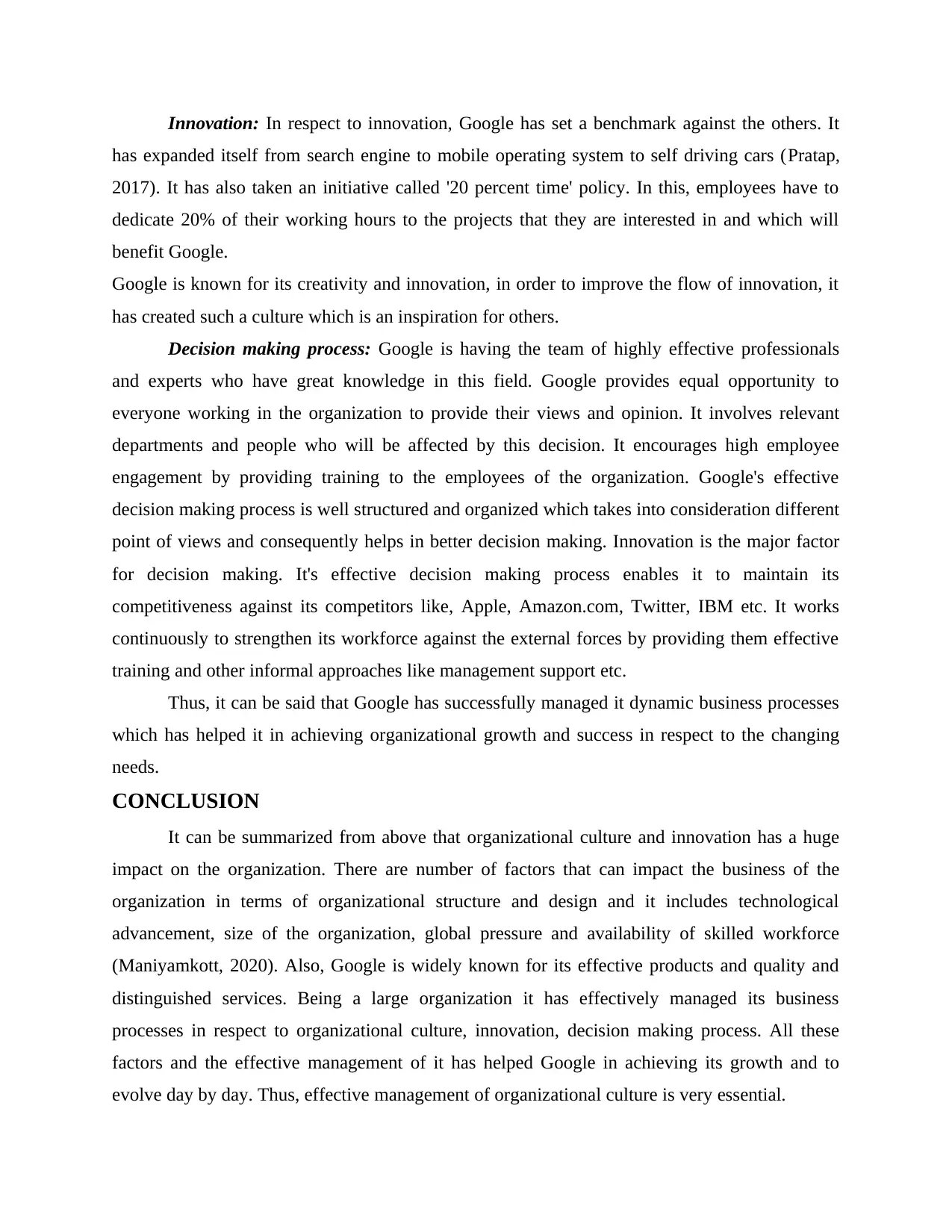
Innovation: In respect to innovation, Google has set a benchmark against the others. It
has expanded itself from search engine to mobile operating system to self driving cars (Pratap,
2017). It has also taken an initiative called '20 percent time' policy. In this, employees have to
dedicate 20% of their working hours to the projects that they are interested in and which will
benefit Google.
Google is known for its creativity and innovation, in order to improve the flow of innovation, it
has created such a culture which is an inspiration for others.
Decision making process: Google is having the team of highly effective professionals
and experts who have great knowledge in this field. Google provides equal opportunity to
everyone working in the organization to provide their views and opinion. It involves relevant
departments and people who will be affected by this decision. It encourages high employee
engagement by providing training to the employees of the organization. Google's effective
decision making process is well structured and organized which takes into consideration different
point of views and consequently helps in better decision making. Innovation is the major factor
for decision making. It's effective decision making process enables it to maintain its
competitiveness against its competitors like, Apple, Amazon.com, Twitter, IBM etc. It works
continuously to strengthen its workforce against the external forces by providing them effective
training and other informal approaches like management support etc.
Thus, it can be said that Google has successfully managed it dynamic business processes
which has helped it in achieving organizational growth and success in respect to the changing
needs.
CONCLUSION
It can be summarized from above that organizational culture and innovation has a huge
impact on the organization. There are number of factors that can impact the business of the
organization in terms of organizational structure and design and it includes technological
advancement, size of the organization, global pressure and availability of skilled workforce
(Maniyamkott, 2020). Also, Google is widely known for its effective products and quality and
distinguished services. Being a large organization it has effectively managed its business
processes in respect to organizational culture, innovation, decision making process. All these
factors and the effective management of it has helped Google in achieving its growth and to
evolve day by day. Thus, effective management of organizational culture is very essential.
has expanded itself from search engine to mobile operating system to self driving cars (Pratap,
2017). It has also taken an initiative called '20 percent time' policy. In this, employees have to
dedicate 20% of their working hours to the projects that they are interested in and which will
benefit Google.
Google is known for its creativity and innovation, in order to improve the flow of innovation, it
has created such a culture which is an inspiration for others.
Decision making process: Google is having the team of highly effective professionals
and experts who have great knowledge in this field. Google provides equal opportunity to
everyone working in the organization to provide their views and opinion. It involves relevant
departments and people who will be affected by this decision. It encourages high employee
engagement by providing training to the employees of the organization. Google's effective
decision making process is well structured and organized which takes into consideration different
point of views and consequently helps in better decision making. Innovation is the major factor
for decision making. It's effective decision making process enables it to maintain its
competitiveness against its competitors like, Apple, Amazon.com, Twitter, IBM etc. It works
continuously to strengthen its workforce against the external forces by providing them effective
training and other informal approaches like management support etc.
Thus, it can be said that Google has successfully managed it dynamic business processes
which has helped it in achieving organizational growth and success in respect to the changing
needs.
CONCLUSION
It can be summarized from above that organizational culture and innovation has a huge
impact on the organization. There are number of factors that can impact the business of the
organization in terms of organizational structure and design and it includes technological
advancement, size of the organization, global pressure and availability of skilled workforce
(Maniyamkott, 2020). Also, Google is widely known for its effective products and quality and
distinguished services. Being a large organization it has effectively managed its business
processes in respect to organizational culture, innovation, decision making process. All these
factors and the effective management of it has helped Google in achieving its growth and to
evolve day by day. Thus, effective management of organizational culture is very essential.
Paraphrase This Document
Need a fresh take? Get an instant paraphrase of this document with our AI Paraphraser
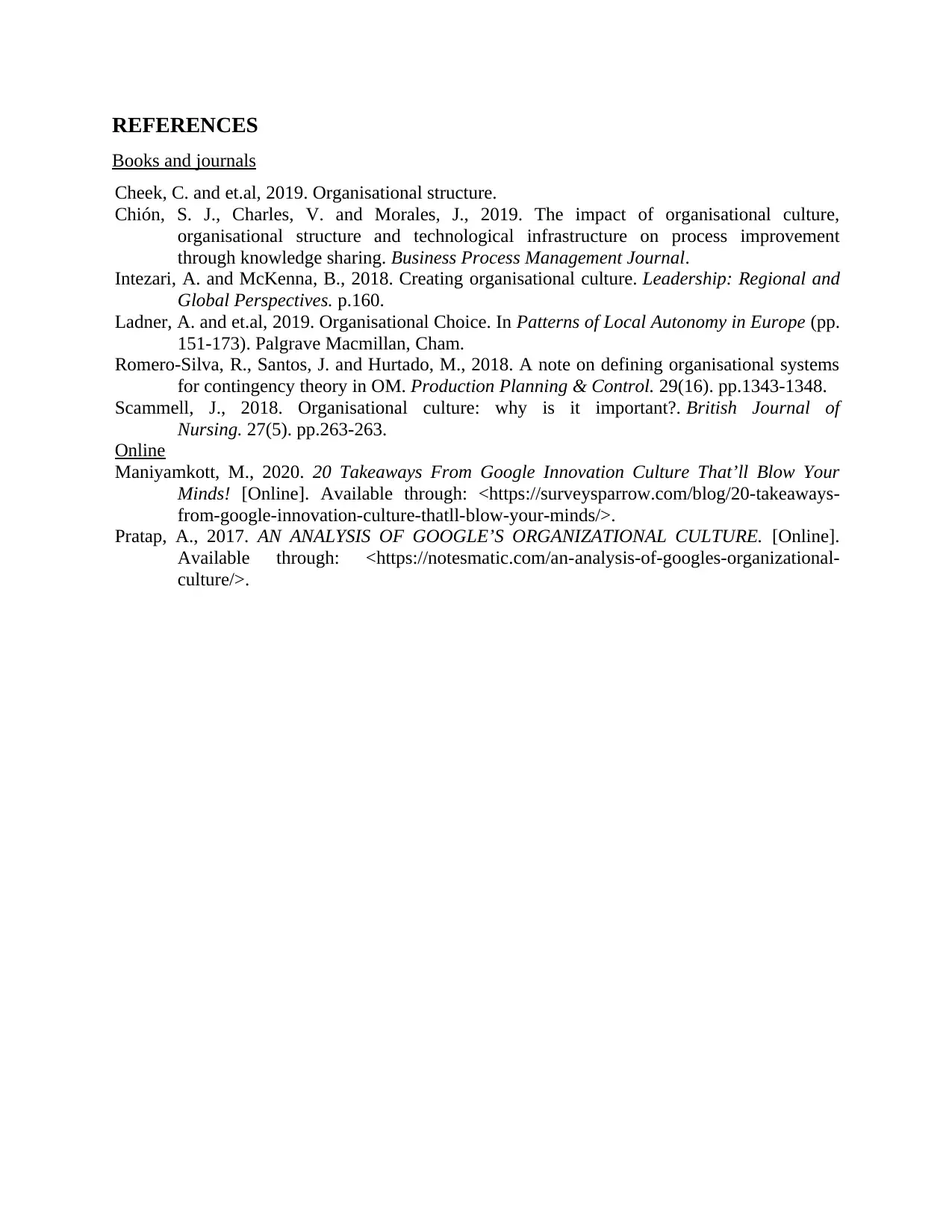
REFERENCES
Books and journals
Cheek, C. and et.al, 2019. Organisational structure.
Chión, S. J., Charles, V. and Morales, J., 2019. The impact of organisational culture,
organisational structure and technological infrastructure on process improvement
through knowledge sharing. Business Process Management Journal.
Intezari, A. and McKenna, B., 2018. Creating organisational culture. Leadership: Regional and
Global Perspectives. p.160.
Ladner, A. and et.al, 2019. Organisational Choice. In Patterns of Local Autonomy in Europe (pp.
151-173). Palgrave Macmillan, Cham.
Romero-Silva, R., Santos, J. and Hurtado, M., 2018. A note on defining organisational systems
for contingency theory in OM. Production Planning & Control. 29(16). pp.1343-1348.
Scammell, J., 2018. Organisational culture: why is it important?. British Journal of
Nursing. 27(5). pp.263-263.
Online
Maniyamkott, M., 2020. 20 Takeaways From Google Innovation Culture That’ll Blow Your
Minds! [Online]. Available through: <https://surveysparrow.com/blog/20-takeaways-
from-google-innovation-culture-thatll-blow-your-minds/>.
Pratap, A., 2017. AN ANALYSIS OF GOOGLE’S ORGANIZATIONAL CULTURE. [Online].
Available through: <https://notesmatic.com/an-analysis-of-googles-organizational-
culture/>.
Books and journals
Cheek, C. and et.al, 2019. Organisational structure.
Chión, S. J., Charles, V. and Morales, J., 2019. The impact of organisational culture,
organisational structure and technological infrastructure on process improvement
through knowledge sharing. Business Process Management Journal.
Intezari, A. and McKenna, B., 2018. Creating organisational culture. Leadership: Regional and
Global Perspectives. p.160.
Ladner, A. and et.al, 2019. Organisational Choice. In Patterns of Local Autonomy in Europe (pp.
151-173). Palgrave Macmillan, Cham.
Romero-Silva, R., Santos, J. and Hurtado, M., 2018. A note on defining organisational systems
for contingency theory in OM. Production Planning & Control. 29(16). pp.1343-1348.
Scammell, J., 2018. Organisational culture: why is it important?. British Journal of
Nursing. 27(5). pp.263-263.
Online
Maniyamkott, M., 2020. 20 Takeaways From Google Innovation Culture That’ll Blow Your
Minds! [Online]. Available through: <https://surveysparrow.com/blog/20-takeaways-
from-google-innovation-culture-thatll-blow-your-minds/>.
Pratap, A., 2017. AN ANALYSIS OF GOOGLE’S ORGANIZATIONAL CULTURE. [Online].
Available through: <https://notesmatic.com/an-analysis-of-googles-organizational-
culture/>.
1 out of 8
Related Documents
Your All-in-One AI-Powered Toolkit for Academic Success.
+13062052269
info@desklib.com
Available 24*7 on WhatsApp / Email
![[object Object]](/_next/static/media/star-bottom.7253800d.svg)
Unlock your academic potential
Copyright © 2020–2025 A2Z Services. All Rights Reserved. Developed and managed by ZUCOL.




